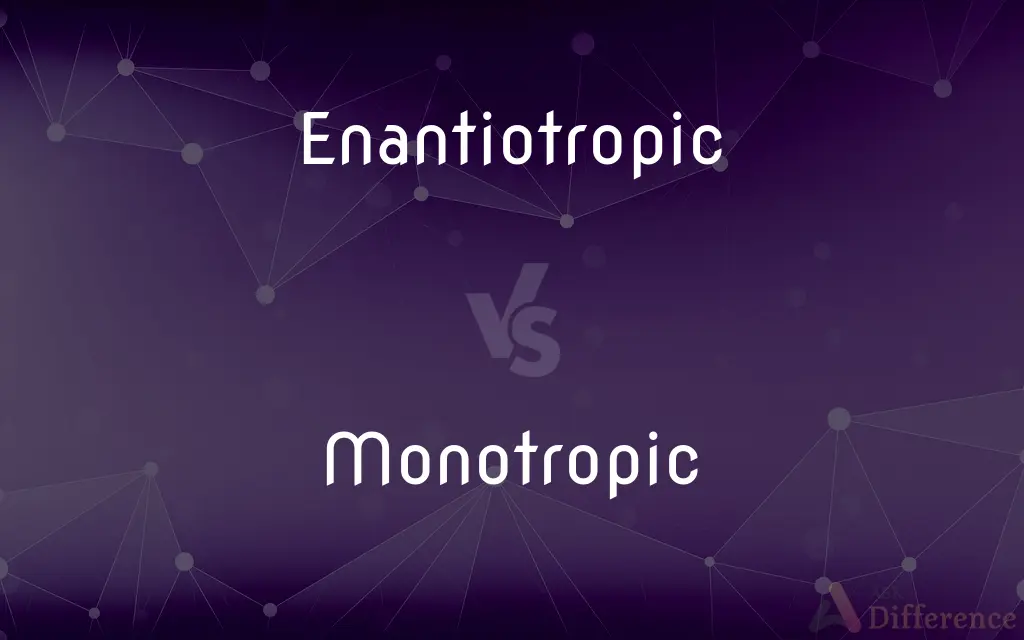Enantiotropic vs. Monotropic — What's the Difference?
Edited by Tayyaba Rehman — By Fiza Rafique — Updated on March 20, 2024
Enantiotropic refers to substances with reversible polymorphic transitions, while monotropic involves irreversible polymorphic changes.

Difference Between Enantiotropic and Monotropic
Table of Contents
ADVERTISEMENT
Key Differences
Enantiotropic substances can exist in multiple crystal forms (polymorphs) that are reversible and can transform into each other depending on conditions like temperature and pressure, whereas monotropic systems involve polymorphs where the transition is one-way and irreversible under normal conditions.
In enantiotropic systems, there's typically a temperature at which two polymorphs are in equilibrium, meaning one form can change into another and vice versa, while in monotropic systems, once a polymorph transforms into a more stable form, it cannot revert back under normal conditions.
The study of enantiotropy is crucial in fields like pharmaceuticals and materials science, where the different physical properties of polymorphs (like solubility and melting point) can significantly affect a substance's performance and stability, whereas understanding monotropic behavior is essential for ensuring the stability and integrity of materials and compounds over time.
Enantiotropic behavior often requires careful control of environmental conditions to maintain a desired polymorph, which can be crucial for the efficacy and shelf life of pharmaceuticals, while monotropic systems may offer greater stability but less flexibility in terms of manipulating physical properties.
Comparison Chart
Polymorphic Transition
Reversible between polymorphs under certain conditions
Irreversible, with one form being permanently more stable
ADVERTISEMENT
Equilibrium
Two polymorphs can be in equilibrium at a specific temperature
No equilibrium; once transformed, the change is permanent
Reversibility
Changes between polymorphs can be reversed
Changes are one-way and cannot be reversed
Importance
Crucial in pharmaceuticals for efficacy and materials science for properties
Essential for material stability and integrity
Stability
Polymorph stability can vary with conditions
One polymorph is always more stable, leading to inherent stability of the system
Compare with Definitions
Enantiotropic
Requires control of environmental conditions.
Maintaining a specific humidity level is essential for an enantiotropic substance's stability.
Monotropic
Systems with irreversible polymorphic changes.
In a monotropic system, once polymorph A converts to B, it cannot revert.
Enantiotropic
Substances with reversible polymorphic transitions.
An enantiotropic substance can switch between polymorphs A and B with temperature changes.
Monotropic
Essential for long-term material stability.
Monotropic polymorphism ensures the stability of a compound in storage.
Enantiotropic
Crucial for pharmaceuticals' efficacy and shelf life.
The enantiotropic nature of a drug affects its solubility and absorption rate.
Monotropic
Less flexibility in property manipulation.
Monotropic substances offer limited options for altering physical properties.
Enantiotropic
Equilibrium between polymorphs at specific conditions.
At 100°C, polymorphs A and B of an enantiotropic substance are in equilibrium.
Monotropic
Permanent stability in one polymorphic form.
Polymorph B in a monotropic system remains stable regardless of environmental changes.
Enantiotropic
Polymorphs have distinct physical properties.
Each polymorph of an enantiotropic compound may have a different melting point.
Monotropic
Characterized by one-way transitions.
The transition from less stable to more stable form in a monotropic system is one-way.
Enantiotropic
Of, pertaining to, or exhibiting enantiotropism
Monotropic
Describing any material that exists in multiple forms, only one of which is stable at all temperatures and pressures
Monotropic
That collects pollen the flowers of only one species
Common Curiosities
What does monotropic mean in terms of polymorphism?
Monotropic refers to polymorphic systems where one form is permanently more stable, making the transition to this form irreversible under normal conditions.
Why is the study of enantiotropy important in pharmaceuticals?
The physical properties of different polymorphs, such as solubility, can significantly affect a drug's efficacy, bioavailability, and stability.
How is polymorphism detected in enantiotropic substances?
Techniques like differential scanning calorimetry (DSC) and X-ray diffraction (XRD) can identify and differentiate between polymorphic forms in enantiotropic substances.
What is enantiotropy in polymorphism?
Enantiotropy involves reversible polymorphic transitions where different crystal forms of a substance can interconvert under varying conditions.
What role do environmental conditions play in enantiotropy and monotropy?
Environmental conditions, such as temperature and humidity, can influence the stability and transition between polymorphs in enantiotropic substances, while in monotropic substances, the stable form remains unaffected by these conditions.
How does temperature affect enantiotropic and monotropic systems?
In enantiotropic systems, temperature can induce reversible transitions between polymorphs. In monotropic systems, temperature changes may lead to irreversible transitions to a more stable form.
Can a substance exhibit both enantiotropic and monotropic behavior?
A substance might display enantiotropic behavior under certain conditions and monotropic under others, depending on factors like pressure and temperature.
What challenges do enantiotropic polymorphisms pose in formulation development?
Developing formulations of enantiotropic substances requires careful control of environmental conditions to ensure the desired polymorph is maintained, which can be challenging.
Can enantiotropic behavior be manipulated for technological applications?
Yes, manipulating enantiotropic behavior can be beneficial in designing materials with specific properties, such as responsive or adaptive materials.
What are the implications of monotropy in materials storage?
Monotropy ensures that a material remains in its most stable form, which is beneficial for the long-term stability and integrity of stored materials.
How do enantiotropic transitions impact material science?
Enantiotropic behavior can affect a material's properties, such as melting point and mechanical strength, impacting its applications and processing.
How can the irreversible nature of monotropic transitions be advantageous?
The irreversible transition to a more stable form can be advantageous for maintaining the consistent performance and stability of materials over time.
What factors determine whether a substance will exhibit enantiotropy or monotropy?
Factors like molecular structure, intermolecular forces, and external conditions like temperature and pressure can influence whether a substance exhibits enantiotropy or monotropy.
Are there any risks associated with the use of substances exhibiting enantiotropy?
The risk lies in the unintended conversion to an undesired polymorph, which can alter the substance's performance and stability, particularly in pharmaceuticals and materials with critical applications.
How does polymorphism impact regulatory approval in pharmaceuticals?
Regulatory agencies require a thorough understanding of a drug's polymorphic forms due to their potential impact on safety, efficacy, and quality.
Share Your Discovery

Previous Comparison
Rayon vs. Viscose
Next Comparison
Fatwah vs. FatwaAuthor Spotlight
Written by
Fiza RafiqueFiza Rafique is a skilled content writer at AskDifference.com, where she meticulously refines and enhances written pieces. Drawing from her vast editorial expertise, Fiza ensures clarity, accuracy, and precision in every article. Passionate about language, she continually seeks to elevate the quality of content for readers worldwide.
Edited by
Tayyaba RehmanTayyaba Rehman is a distinguished writer, currently serving as a primary contributor to askdifference.com. As a researcher in semantics and etymology, Tayyaba's passion for the complexity of languages and their distinctions has found a perfect home on the platform. Tayyaba delves into the intricacies of language, distinguishing between commonly confused words and phrases, thereby providing clarity for readers worldwide.















































